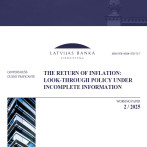The annual inflation level characterizes a moderately growing economy
In April, the annual inflation level grew to 0.7%. One of the reasons for the rise in annual inflation was the gradual shrinking of the negative contribution of several goods and services prices, which formed, as of 2013, because of dropping prices. For thermal energy and fuel, for instance, it is explained by the so-called base effect: in April of last year, the prices of oil (and, accordingly, fuel) and thermal energy dropped, whereas in April of this year, the price of oil in the global market did not change substantially and the possibilities of a substantial reduction in thermal energy prices might be exhausted for the time being. Compared to March, the negative contribution of prices of unprocessed food (which is also supply-related, seasonal group of goods) diminished while the prices of processed foods (dairy and cereal products) rose.
Although the negative contribution of supply-side factors (both the direct and indirect – through costs in other groups of goods) to inflation is diminishing this year and it is one of the reasons why total inflation has moved out of the negative territory, core inflation is also higher this year than the average for 2013. With a slight lag, core inflation is reflecting economic growth. A gradual rise in core inflation out of the negative zone and into the positive was observed already last year and, as expected, right now core inflation has stabilized at above 1%.
April saw the contribution of such core inflation generating goods and services prices that can in part be related to Easter in the second half of April, but, in all likelihood not as much as in those euro area countries that are popular tourist destinations for religious events as well as entertainment and shopping trips. Prices of accommodation services, for instance, grew more than in April of last year.
The impact of economic growth can be gradually observed in such examples as a slightly increased influence of some seasonally changing prices. For example, the seasonal rise in footwear prices this year exceeds the average of several previous years. The prices of alcohol (for which sales were observed in March) and, slightly, those of tobacco products went up.
However, according to the Central Statistical Bureau estimations, the economy grew at a slower rate in the first quarter of this year, and that is one of the factors that keeps total inflation at such a low level. The consumer survey conducted by the European Commission in April indicates that inflation expectations are continuing to decrease in Latvia, i.e. the percentage of those respondents who believe that the price level will rise rapidly in the course of next year is shrinking. Although postponing the liberalization of the electrical power market to 2015 could still be among the reasons for such perceptions of price development, the observations of actual prices and a moderate rise in income does not invite predictions of a rapid rise in prices.
The world food prices dropped slightly in April, mostly reflecting a longer season for the New Zealand dairy exporters and a shrunken demand for dairy products from China and Russia. The concern over the harvest in the United States has also abated, because the weather conditions have improved. Yet these are not constant price-impacting factors and may not constitute a trend. In the coming periods, a substantial pressure of inflation is not expected because of domestic factors and the main risks are related to the global food and energy price developments.
Textual error
«… …»






